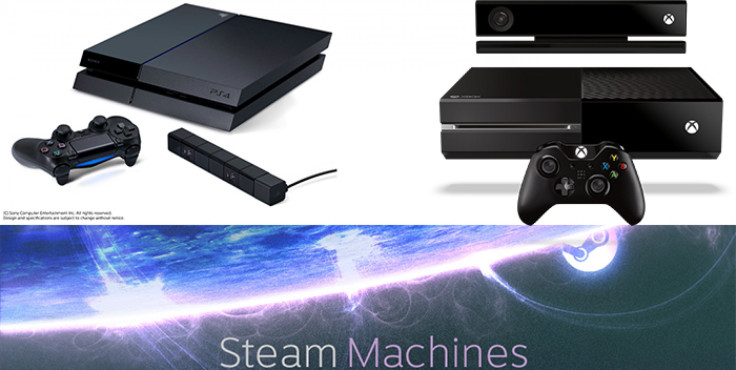Microsoft Xbox One Vs. Sony PlayStation 4 Vs. PC: 'Resolutiongate' 720p Controversy; Is There An Alternative Other Than PS4?

The resolution and frame rate of games being released on next-gen consoles such as the Microsoft (NASDAQ:MSFT) Xbox One and the Sony (NYSE:SNE) PlayStation 4 (PS4) have continued to be a contentious issue for players looking forward to purchasing these next-gen consoles on their release dates on Nov. 22 and Nov. 15 respectively.
The controversy, which some players have dubbed “Resolutiongate,” continues to be a problem for the Xbox One as more games are being added to the list of games that are rendered at 720p and then up-scaled to 1080p.
In an interview with Eurogamer, Josh Bridge, executive producer of “Dead Rising 3,” revealed that the Xbox One exclusive will run natively at 720p at 30 frames per second (FPS).
Earlier last week, it was revealed that the next-gen version of Infinity Ward’s “Call of Duty: Ghosts” would be rendered 720p on the Xbox One on launch while it would run a native 1080p on the PlayStation 4. Electronic Arts (NYSE:EA) along with its Sweden-based DICE’s “Battlefield 4 (BF4)” reportedly will suffer a similar issue with “BF4” rendered at 720p on the Xbox One compared to 900p on the PS4.
Another game reportedly not being rendered at a native 1080p resolution is the Xbox One exclusive, “Ryse: Son of Rome” which will run at 900p at 30 FPS, according to Microsoft.
While this isn’t the case for all games that will be available on release day for the Xbox One, many of the games for PS4 will render at 1080p natively, including “KillZone: Shadow Fall,” “Thief,” “Assassin’s Creed 4: Black Flag,” and more.
To demonstrate the capabilities and quality of games on the PlayStation 4, Sony released “ultra-high” bitrate multiplayer gameplay footage of its upcoming “Killzone: Shadow Fall” that can only be downloaded and not streamed.
In fairness, frame rates and resolution are not the only factors that decide whether or not a game is decidedly next-gen quality. However, the inability for some developers to hit that mark of rendering games at a native 1080p does spark questions about whether or not the Xbox One and the PS4 can meet expectations for next-gen graphics and quality.
In theory, the shift of the Xbox One and the PlayStation 4 to an X86-64 instruction set was supposed to make it easier for developers to produce higher quality games across multiple platforms. However, the design choices picked by Microsoft and Sony have proven to be a constraint for developers. For example, the ESRAM on the Xbox One has proven to be problematic bottleneck for developers looking to utilize the Xbox One to its fullest extent.
Despite these issues, as developers become more acclimated to the development environments of the Xbox One and the PS4, game performance and quality will likely improve throughout their lifecycle. On the other hand, both Microsoft and Sony have had ample time to develop the Xbox One and PlayStation 4 respectively. Considering those factors, maybe there’s room for a different upgrade path for players looking for a more modern system to play games on—PC-based gaming.
PC gaming is somewhat more daunting to jump into compared to console gaming of the Xbox One and PS4 variety, sometimes requiring users to modify game files edit configurations to get games working at their best. Valve Software is attempting to break down that barrier with the introduction of the Steam Machine (previously rumored to be named “Steam Box”), which may be the answer gamers are looking for.
Unlike consoles such as the upcoming Xbox One and the PS4, the Steam Machine, is not necessarily a console with a set configuration. Utilizing a Unix-like operating system, called SteamOS, Valve hopes to provide a wider variety of configuration options for players looking to expand their living room experience.
Later in 2014, those looking to purchase a Steam Machine can purchase different configurations at different price points from different manufacturers. However, the more hands-on player can also build their own machine to customize their Steam Machine to their liking, while also gaining access to huge selection of nearly 3,000 games available on the Steam digital distribution platform.
Not too long ago, PC-based gaming would have been written off in entirety by some gamers. However, digital distribution platforms such as Steam have proven the PC to be a growing market segment, especially after Steam’s active users rose to 65 million in October, eclipsing the Xbox Live user base, according to The Verge.
Regardless of what the future is for next-gen gaming, the shortcomings of the Xbox One and the PS4 will make it more likely for players to consider more options than they have in the past.
Let us know your thoughts on next-gen gaming with the Microsoft Xbox One, Sony PlayStation 4, PC and the Steam Machine in the comments.
© Copyright IBTimes 2024. All rights reserved.












